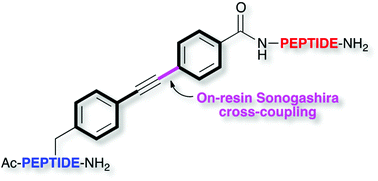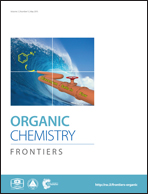Synthesis of bisarylethyne–peptide conjugates†
Abstract
Peptide-conjugates with unsaturated carbon chains form attractive molecules that can contribute to both medicinal chemistry and advanced materials sciences. Here, a convenient Fmoc-based solid-phase peptide synthesis method for the preparation of bisarylethyne-conjugates is described. This method allows coupling of an iodo-aryl or aryl-acetylene to resin-bound aryl-acetylene or iodo-aryl containing peptides using catalytic amounts of (PPh3)2PdCl2 and CuI in the presence of DiPEA. The triple bond is reduced quantitatively when 10% silane, either TES or TIS, is present in the acidic cleavage cocktail; deuterated bisarylethylene-species were obtained using deuterated cleavage reagents. Importantly, reduction of the triple-bond is completely suppressed using TFA and phenol as scavengers, and bisarylethyne–peptide conjugates were obtained.

- This article is part of the themed collection: Celebrating the 80th Birthday of Professor Ei-ichi Negishi


 Please wait while we load your content...
Please wait while we load your content...